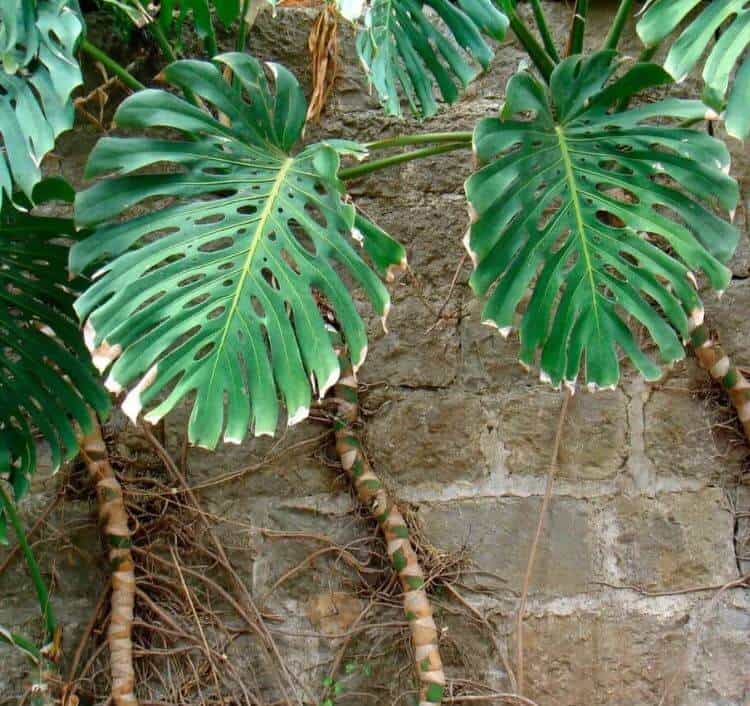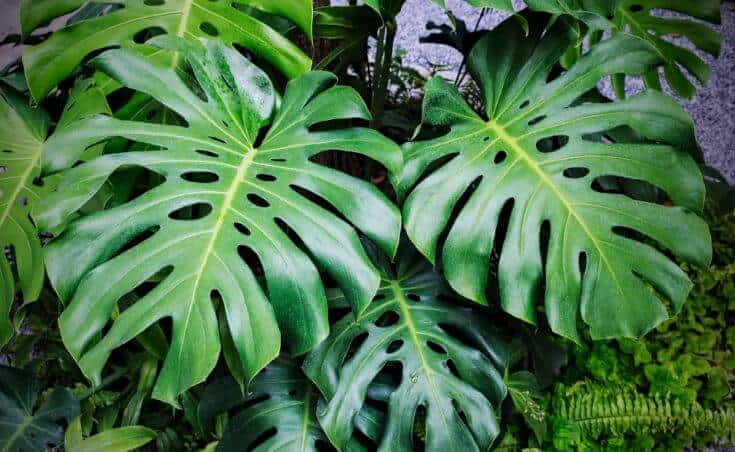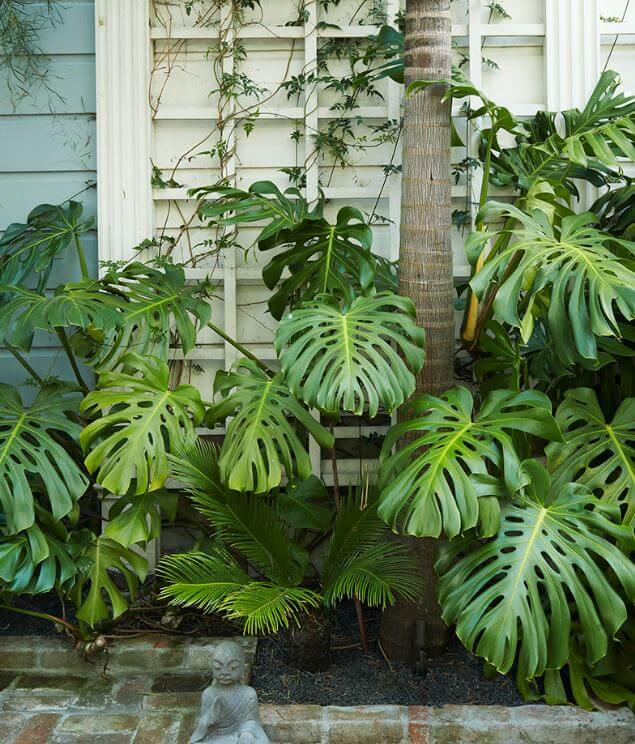Last Updated on September 5, 2023 by a Friendly Gardener
When looking for a hardy houseplant that can be cultivated outside, the Monstera deliciosa might appear on your list. These plants are hardy and difficult to kill unless they are overwatered or kept in the dark. The environmental temperature can create problems if it drops below 40°F.
Can Monsteras live outside?

If you live in a location that has a tropical climate or similar, yes, Monstera plants can be cultivated in your outdoor garden. These plants are native to Central and South American regions, so the outdoor climate needs to replicate this. Monstera will attach to trees, other vegetation, and structures as vining plants. If local winter temperatures fall below 40°F., a Monstera grown outdoors may die.
One advantage when you grow Monstera outside is that it will benefit the plant with increased light exposure if you do not place your plant in a spot where leaves can become sunburnt. These plants thrive in bright light, warmth, and humidity. With the proper environmental conditions, a Monstera may reward you with large, fenestrated foliage.
When well cultivated indoors, the Monstera can reach heights of 15 feet, while in an ideal outdoor climate, they may even double that, arriving as high as 30 feet. The recommended USDA hardiness zones for outdoor cultivation are zones 10 through 12. Depending on the outdoor climate, your Monstera may require watering more often, and it’s essential to evaluate the outdoor humidity as more arid climates may produce crispy leaf edges.
Invasive or Not?

Monstera Deliciosa are often considered plant monsters as they are pretty invasive. States like Florida and Hawaii consider Monstera intrusive and recommend planting them cautiously, although they are not banned. The risk is that the Monstera can overtake local ecosystem vegetation. Although it may be fantastic to behold, you don’t want it to do so at the expense of other garden members.
Acclimating a Monstera Plant for Outdoor Cultivation

If you have an indoor monstera plant you want to move outside, it’s a good idea to acclimate it before casting it out to fend for itself. Begin by moving your plant outside to a shady spot or placing it in overcast, cloudy weather. Bring the plant back indoors in the evening. Do this daily for a few weeks before leaving the Monstera outside indefinitely.
Gardens that face north or east may not present a problem, whereas southern-facing gardens or western-facing spots may feature strong sunlight that is too harsh and may place your plant at risk for burning and wilting. If you notice the Monstera struggling outside, immediately bring it back indoors.
If the outdoor climate is sweltering, ensure your plant is in the shade. A shady spot in your yard or garden will always provide more natural light than a bright indoor perch. Remember that Monstera are susceptible to burning, so they must be acclimated. Should your Monstera experience scorching, remove the damaged foliage that is no longer green. Leave your plant outside but be sure to water it on a regular schedule. Theoretically, new foliage growth should contain more carotenoids that act as a plant’s sunscreen so your plant will naturally develop an increased tolerance for outdoor sunlight.
What Temperatures Can Monstera Tolerate?
Indoors, Monstera like temperatures measuring in the range of 60° to 80° F. It does not like sudden drops in environmental temperatures, nor appreciate temps measuring below 55°F. Anything below 40°F can be fatal.
Planting Your Monstera Outdoors

Some home gardeners like to bring their potted Monstera outdoors in the warmer seasons but then return them indoors when winter nears. If you wish to transplant a Monstera plant outdoors, you need to select a proper spot, and it should be a location where there is no direct sunlight. When choosing, keep in mind these necessities:
-
Light
Indoor Monstera plants like generous amounts of bright indirect light, so an outdoor Monstera needs a shady spot. The Monstera can manage two to three hours of direct sunlight daily, but more prolonged exposure may harm the foliage.
-
Water
The Monstera Deliciosa likes evenly moist soil beds but will not suffer soggy soil. When cultivating a Monstera in an outdoor garden, keep the garden bed moist, particularly in the summer heat. Growing other vegetation around your Monstera may aid the soil’s moisture retention, as in its natural habitat.
-
Soil
The Monstera needs well-draining soil because the delicate root system will not tolerate sitting in water, so your plant needs a loose textured soil mix.
-
Temperature
How cold can Monstera tolerate? Temperatures that fall below 40°F repeatedly or for any extended period will place your plant at risk. Freezing temperatures can kill it. If you have outdoor Monstera, you may need protection if the temps fall.
-
Support
One reason that outdoor Monstera grow so large is that they climb and can expand. If you are cultivating an outdoor Monstera, supporting structures such as trellises can be essential to keeping your plant healthy and thriving. Monstera are considered invasive due to their vining habit, which can damage or kill other plants. Giving your Monstera a support structure will support the plant’s growth habit while protecting surrounding vegetation and structures.
Monstera Protection

If your region’s outdoor weather puts your plant at risk, you may need protection as winter approaches. You’ll need to select the type of protection based on the plant’s size. If you do not live in an area with a tropical climate, consider placing your plant in a greenhouse, or you can move it indoors. In winter, the Monstera will enter dormancy, and growth may stop.
Cold damage symptoms to look for include:
- Brown foliage
- Drooping leaves
- Foliage discoloration
- Wilting
- Blackened leaves
- Loose root system
Final Thoughts
Planting a Monstera Deliciosa outside will give it more room to grow provide better light exposure, and your plant may even enjoy a bit of rain, all of which will contribute to the plant’s general health. An indoor Monstera must be hardened off before permanently moving outside. Once outside, it should receive dappled light as Mother Nature would provide in its natural habitat. Your Monstera will probably require more water when grown outdoors because the soil bed may dry more rapidly, so check out soil moisture often, and if the temps drop, protect your plant or bring it indoors.

